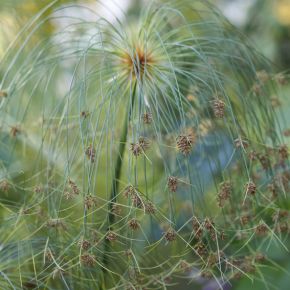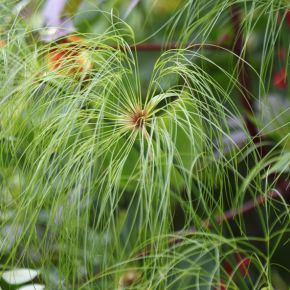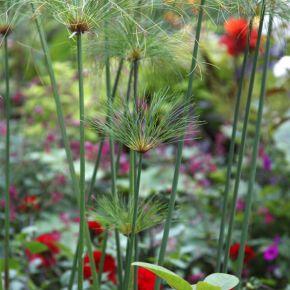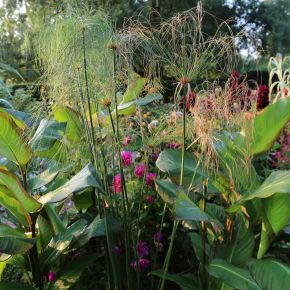Cyperus papyrus
(Egyptian Paper Reed)
Family - Cyperaceae
Category - Perennial
Origin - Africa
Year of Introduction - to Britain in 1803
Season of Interest - Spring, Summer, Autumn, Winter
Hardiness - H1c
Height - 2m
Width - up to 1.2m
Location - The Exotic Garden, The Glasshouse
Description: A clump-forming Evergreen Perennial with an upright habit. Tall, vertical stems with three angles are topped with large, round compound umbels. Small brown flowers are held in small umbels at the tips of the slender filaments and are subtended by fine, dark green needle-like Bracts. The filaments are rigid initially but gradually become pendulous with age. The compound umbels can reach 30cm across and have few dark green Bracts at the base. The stems bear no leaves.
This plant has been historically used, including in ancient Egypt, to make paper. The stems were sliced finely, laid flat and overlapped, then subjected to pressure to bind the fibres together and create sheets of paper.
This plant does best in a warm, sheltered position in shallow water and will need to be overwintered (in this climate) in a heated greenhouse.
Award of Garden Merit (AGM).
Synonym - Papyrus antiquorum
Additional common names - Nile Grass, Papyrus, Egyptian Paper Rush
Flower:
Small brown flowers are held in compound umbels atop tall, vertical stems. The umbels are held at the tips of slender filaments that are rigid at first, but become pendulous with age. Flowering time can be variable depending on growing conditions, but this plant is known to have been in flower in September at Malverleys.
Flower colour: Brown
Flower shape: Small flowers in compound umbels
Flowering time: September
Foliage:
Fine, dark green needle-like Bracts subtend the flowers at the tips of the slender filaments. Few, slightly broader, linear Bracts are held at the base of each of the large umbels. The airy umbels are held at the tips of vertical stems with three angles.
Foliage Senescence: Evergreen
Foliage Shape: Linear to needle-like bracts
Propagation:
Seed.
Cultivation:
Best in a sheltered, humid position in full sun to partial shade in fertile, moisture-retentive soil. This plant is often grown in shallow water and will need to be overwintered in a heated glasshouse (in this climate).



